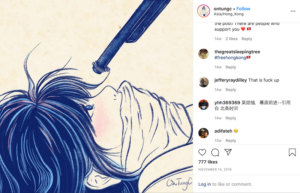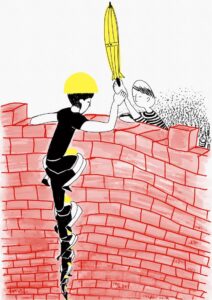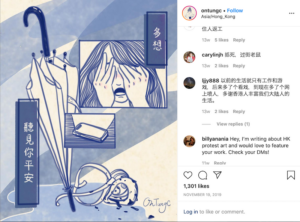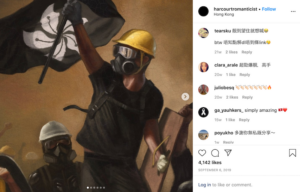
By OnTungC, https://www.instagram.com/ontungc/
All Hong Kong museums, music and performance venues were ordered closed until March in order to discourage crowded gatherings as a result of coronavirus concerns. However, before fears of spreading coronavirus forced the recent closure of many of Hong Kong’s art venues, over 100 arts organizations had been active in continuing citizen rights protests.
In 2020, the artists’ protests continue, sometimes in the streets, and otherwise though the use of open and encrypted social media. Artists play an active part, and artistic responses to the political situation shared over encrypted apps have been made into posters, banners, and signs for political events. These artistic responses to police brutality and calls for a united resistance to oppressive government range from the spontaneous creation of public “Lennon Walls” made of sticky-notes, to drawings and paintings whose images play on past depictions of the French revolution, to anime style figures of youth in uprising. Social media accounts like that of Three Hands Monkey are now sources for sharing political and social artworks as well as news. They are holding Hong Kong’s artistic community together.
Demonstrations, elections, and government push-back

‘From 1989 to 2019’, by Three Hands Monkey, https://twitter.com/ThreeHandsMonk1
Massive demonstrations in Hong Kong began in June 2019 against a Fugitive Offenders and Mutual Legal Assistance in Criminal Matters Legislation (Amendment) Bill that would have given Hong Kong officials the power to allow extradition to China of alleged criminal offenders. Protesters feared that the bill would be used to erode human rights in Hong Kong, specifically, to silence and imprison pro-democracy political activists opposed mainland Chinese rule. The Hong Kong Artists Union was among many who decried the bill as “eroding the freedom of expression on which the work of artists and cultural workers of all disciplines depend,” in an open letter, saying it also would damage the city’s economy and its growth as an international art hub.
After six months of virtually daily demonstrations, local election results giving almost 90% of seats to pro-democracy candidates raised hopes that the ruling structure would be forced to respect the voters’ mandate and deliver on their chief demands for universal suffrage and rejection of the extradition bill. As protests continued, so did police violence that many deemed over-aggressive and unnecessarily brutal.
Last December, just a week after the elections, a peaceful rally calling on the government to meet the electorate’s “five demands” drew tens of thousands of men, women and children into the streets. When police fired off teargas canisters, people fled into the nearby Museum of Art (HKMoA). Police then shot tear gas canisters and pepper spray into the museum itself, potentially threatening artworks as well as people’s health, and damaging the air filtration systems necessary to maintain a proper environment for artworks. The museum had reopened after a two-years long renovation with ten different exhibitions; 20th century works by Wu Guanzhong, Chinese ink paintings from the Chih Lo Lou Collection, the Charter collection of visual records of Hong Kong, works by the New Ink Movement, and an exhibition of artworks loaned by Tate Britain by J.M.W. Turner, John Constable, and David Hockney. Although the museum issued reassurances, it is not known if any of the artworks suffered damage.
Despite coronavirus, protests continue

By OnTungC, https://www.instagram.com/ontungc/
While demonstrations may be smaller as a result of concerns over spreading Coronavirus, Hong Kong residents still gather in protest almost daily, albeit in smaller numbers, and often at night. Public distrust of the Hong Kong government, already widespread, has only increased as it has shown itself incapable of taking firm steps to curtail the virus or initiating any action without explicit directions from the mainland. Protests are also taking new forms. A Hospital Authority Employees Alliance union called for a strike to demand closure of the border with mainland China. The strike petered out, but as a result of heightened political awareness and willingness to stand up for citizen rights, The Alliance’s membership, which had 300 members before the protest, swelled to 18,000.
Coronavirus fears and newly roused political anger at the mainland’s failure to contain it notwithstanding, some Hong Kong galleries are determined to stay open “to support our artists.” Among these are the Axel Vervoordt Gallery, Gallery Exit, Karin Weber Gallery, White Cube, Tang Contemporary Art Hong Kong, Rossi & Rossi, 10 Chancery Lane Gallery, A2Z Art Gallery, de Sarthe Gallery, Pace Gallery, Pearl Lam Galleries, and Cheer Bell Gallery.
Meanwhile, artists work to keep the spirit of the protests alive by sharing creative work with their neighbors and the rest of the world though social media. Visit the Three Hands Monkey Instagram site and the other linked sites for a view of this and many other artists’ work.

“Our Vantage” by Harcourt Romanticist, https://www.instagram.com/harcourtromanticist/.
 “Our Vantage” by Harcourt Romanticist, https://www.instagram.com/harcourtromanticist/.
“Our Vantage” by Harcourt Romanticist, https://www.instagram.com/harcourtromanticist/. 

